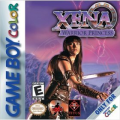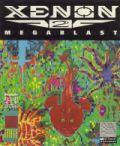Games
Displaying 15551-15560 of 15808 results.
Sega Mega Drive
Release Date: August 26, 1990 |
Genre: Action, Shooter
XDR (エックス・ディー・アール), short for "X-Dazedly-Ray", is a 1990 shoot-'em-up by UNIPACC released for the Sega Mega Drive exclusively in Japan.
The warlord Guardia was banished from the planet Sephiroth, otherwise known to be a very peaceful planet. Many years later, he returns, complete with an entire army which overpowers the Guardian army, leaving one hope: the newly developed XDR craft.
A shoots. Rapidfire is an option "AUTO" under the "CONTROL" option in the Options menu. C changes speed; the current speed is shown in the HUD. Powerups are collected as in other schmups, except that missiles can also be collected, in limited quantities, and fired with B.
Nintendo 64
Release Date: December 14, 1998 |
Genre: Fighting
Xena: Warrior Princess - The Talisman of Fate is a fighting video game that was released on the Nintendo 64, developed by Saffire and published by Titus Software, based on the television series. Characters: Xena, Gabrielle, Autolycus, Joxer, Caesar, Ares, Velasca, Lao Ma, Callisto, Ephiny and Despair (original to the game).
Wii
Release Date: April 6, 2012 |
Genre: RPG
An epic clash between man and machine Available exclusively for the Wii system, the Xenoblade Chronicles game combines science fiction and fantasy into an unforgettable open-world adventure. Players will discover expansive environments and deep character customization options as they delve into an epic conflict between the Homs (humans) and Mechons (robots) and uncover the secret of the ancient Monado blade. With richly detailed role-playing elements, Xenoblade Chronicles offers an extraordinary experience for veteran gamers and genre newcomers alike. Features:
Sony Playstation
Release Date: October 20, 1998 |
Genre: Role-Playing
Xenogears initially takes place on Ignas, the largest continent of the Xenogears world, and the site of a centuries-long war between the nations of Aveh and Kislev.[7] A church-like organization known as the Ethos has excavated gears, ostensibly for the preservation of the world's culture. Although Kislev originally had the upper hand in the war, a mysterious army known as Gebler appeared and began to provide assistance to Aveh. With Gebler's help, the Aveh military not only recovered its losses, but began making its way into Kislev's territory. As the story unfolds, the setting broadens to encompass the entire world and the two floating countries, Shevat and Solaris. Solaris, ruled by Emperor Cain and the Gazel Ministry, commands the Gebler army and the Ethos and secretly uses both to dominate the land-dwellers. Shevat has been the only country to evade the control of Solaris.
Much of Xenogears plot and backstory is detailed in the Japanese-only book Xenogears Perfect Works. This book, produced by the now defunct DigiCube, details the history of the Xenogears universe from the discovery of the Zohar to the start of the game.[8][9] According to the Perfect Works schematic (as well as the game's end credits), Xenogears is the fifth episode in a series of six.
Xenogears follows protagonist Fei Fong Wong and several others as they journey to uncover the truth behind mysterious, cabalistic entities operating in their world. The principles and philosophies of Friedrich Nietzsche, Sigmund Freud, Carl Jung and Jacques Lacan influence the plot, character design, and world of Xenogears. Additionally, the symbols, theological concepts, and devotional practices of several world religions are represented in fictionalized forms in the game. Major psychological themes are the nature of identity and human memory, particularly as these relate to the phenomenon of dissociative identity disorder. The relationship between humanity and machines is central to the game's plot, as indicated by the presence of giant robots dubbed "gears," which each playable character can control.
Amiga
Release Date: August 1, 1989 |
Genre: Shooter
Xenon 2: Megablast is vertically scrolling space shooter, in which you have to pass several levels, filled with waves of enemies, that all end with a level boss creature. Each group of enemies you destroy grants you a cash reward and every once in a while you enter Colin's Bargain Basement, where you can use this cash to purchase upgrades for your ship like better weapons, speed & health upgrades etc. Some upgrades can also be picked up during the levels.
The first part of the game has an organic feel to it, while the second part of the game features mechanical enemies. As there are some maze-like sections with dead-ends in the game, your spaceship scrolls backwards when you keep pressing the down key.
Sony Playstation 2
Release Date: February 25, 2003 |
Genre: Role-Playing
Xenosaga: Episode I - Der Wille zur Macht, the first chapter of a trilogy, is a Japanese-style sci-fi role-playing game, sharing many common themes and gameplay elements with Xenogears. The battle system is not unlike the one used in Xenogears (combo attacks, AP and EP gauges, etc.), but random encounters are eliminated. Instead, the enemies are now visible and battles can be avoided. During combat the few upcoming ally and enemy turns are shown onscreen, allowing the player to make strategic decisions based on who will act next. A rolling slot moves with each turn as well, conferring a bonus such as added damage or bonus XP for any action on that turn. If the enemy would be in position to take an advantage then the player can expend a character's "boost" gauge to cut in and act next, although enemies can boost as well, and enemy boosts always over-ride player boosts.
Each character has a unique tree of Ether spells they can learn by spending Ether points earned in battle, with lower spells requiring spells above them to be purchased first. After a spell is purchased, so long is it does not require a unique talent of that character, the spell can also be purchased and learned by any other character that can afford double its normal cost. The Anti-Gnosis Weapon Systems can be equipped with different weapons and accessories and can be used in combat provided that a character has enough AP on that turn to board their AGWS.






